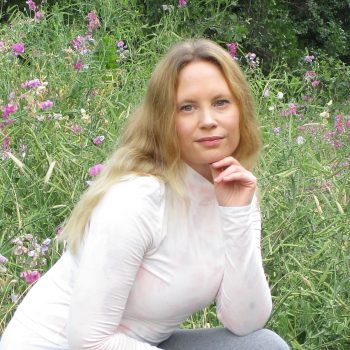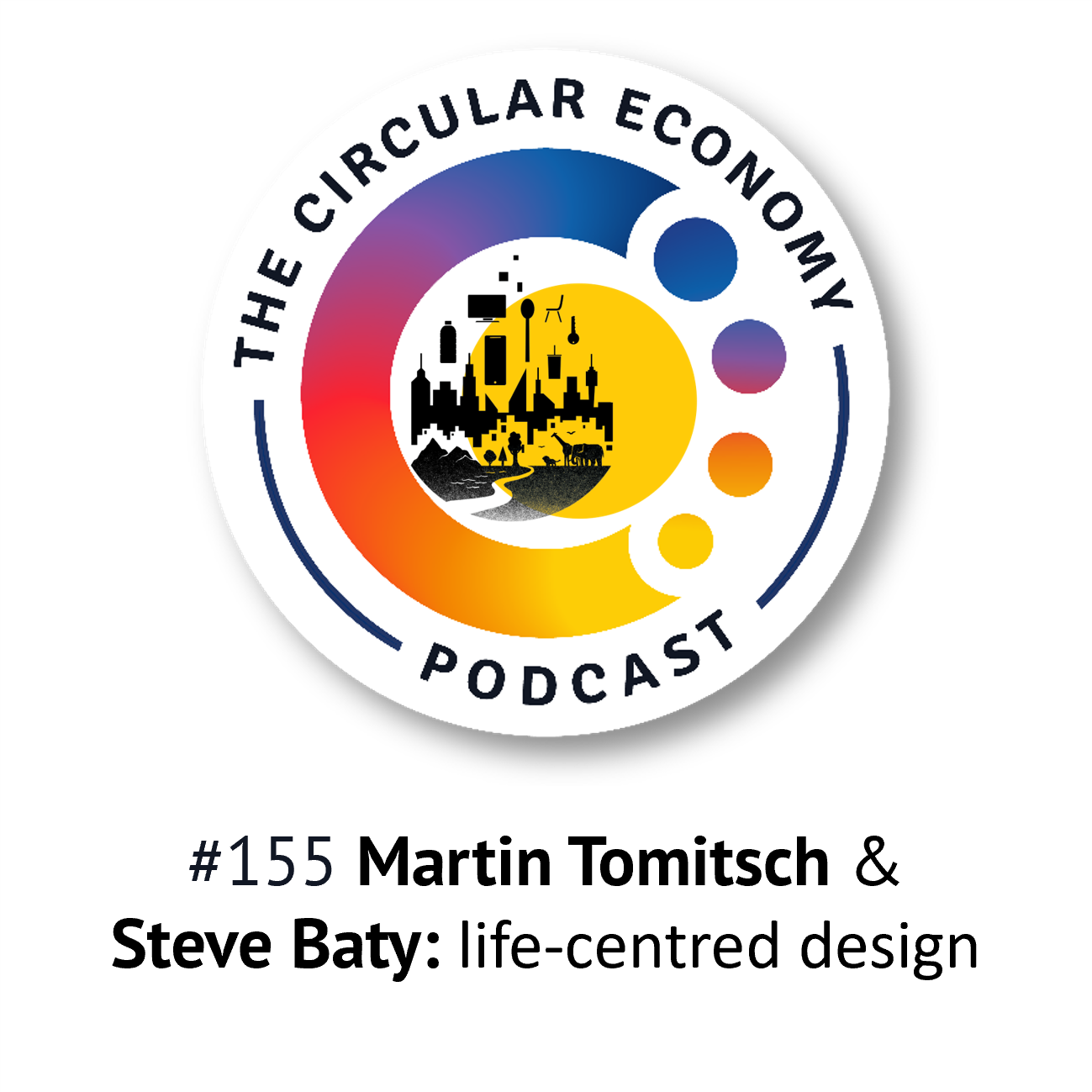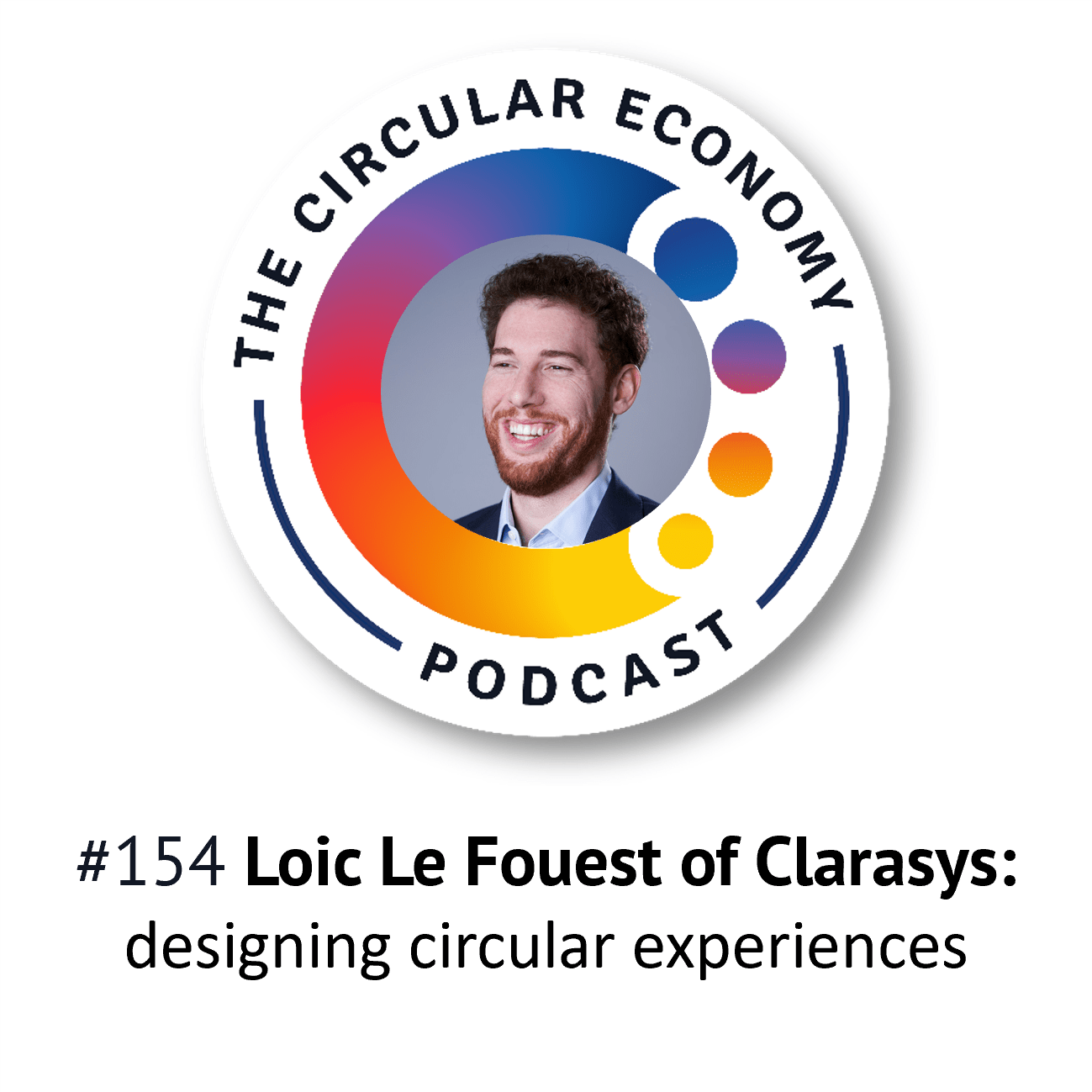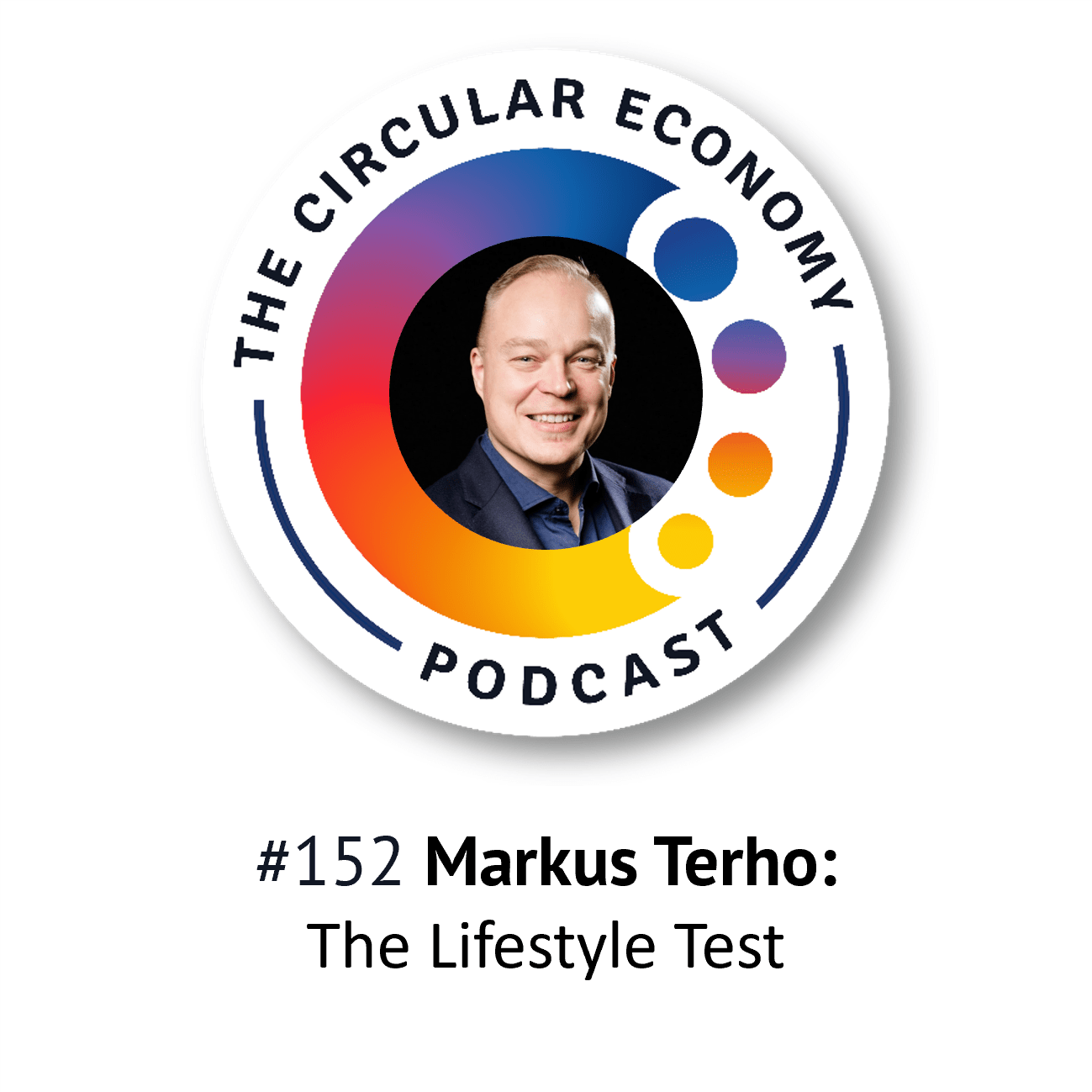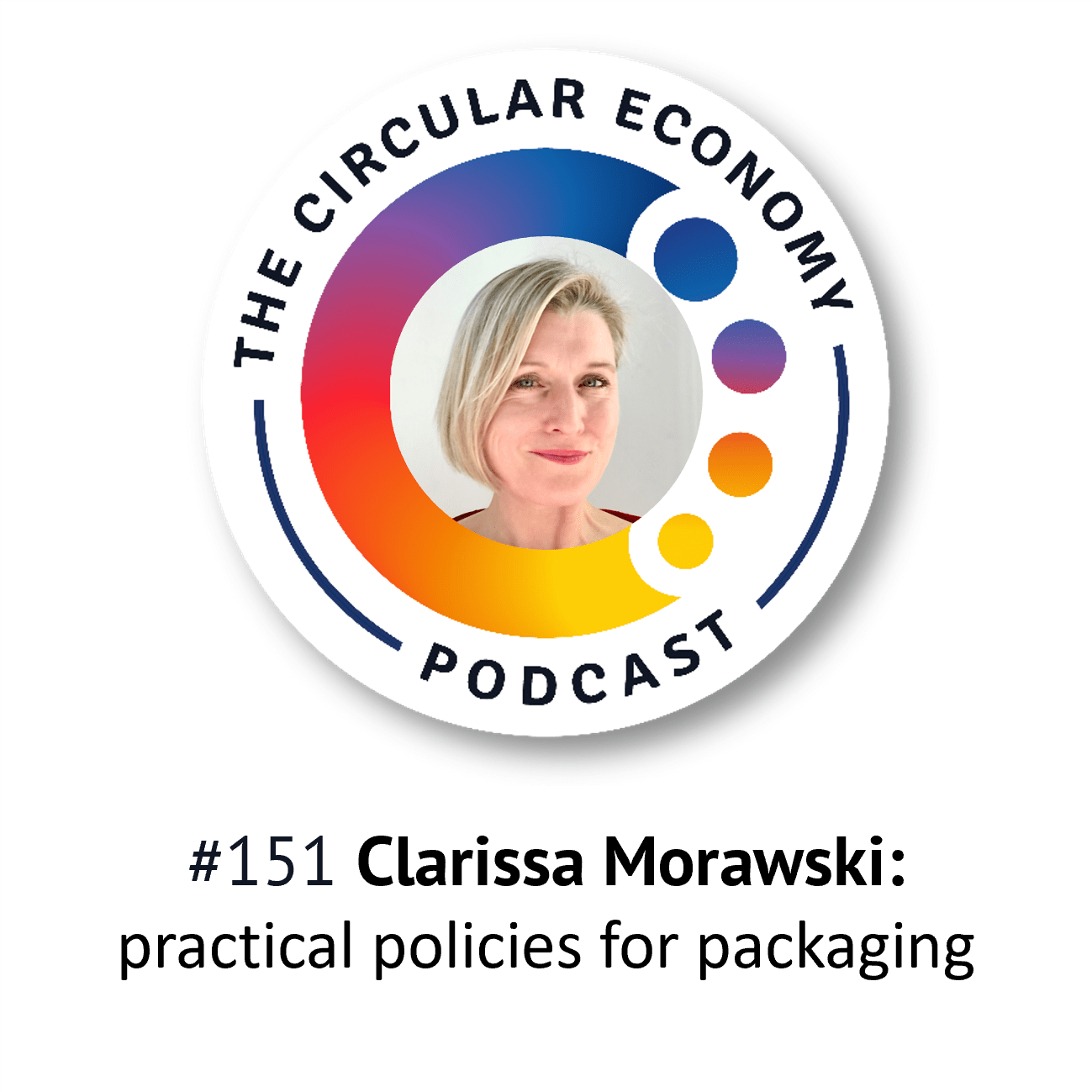Podcast: Play in new window | Download
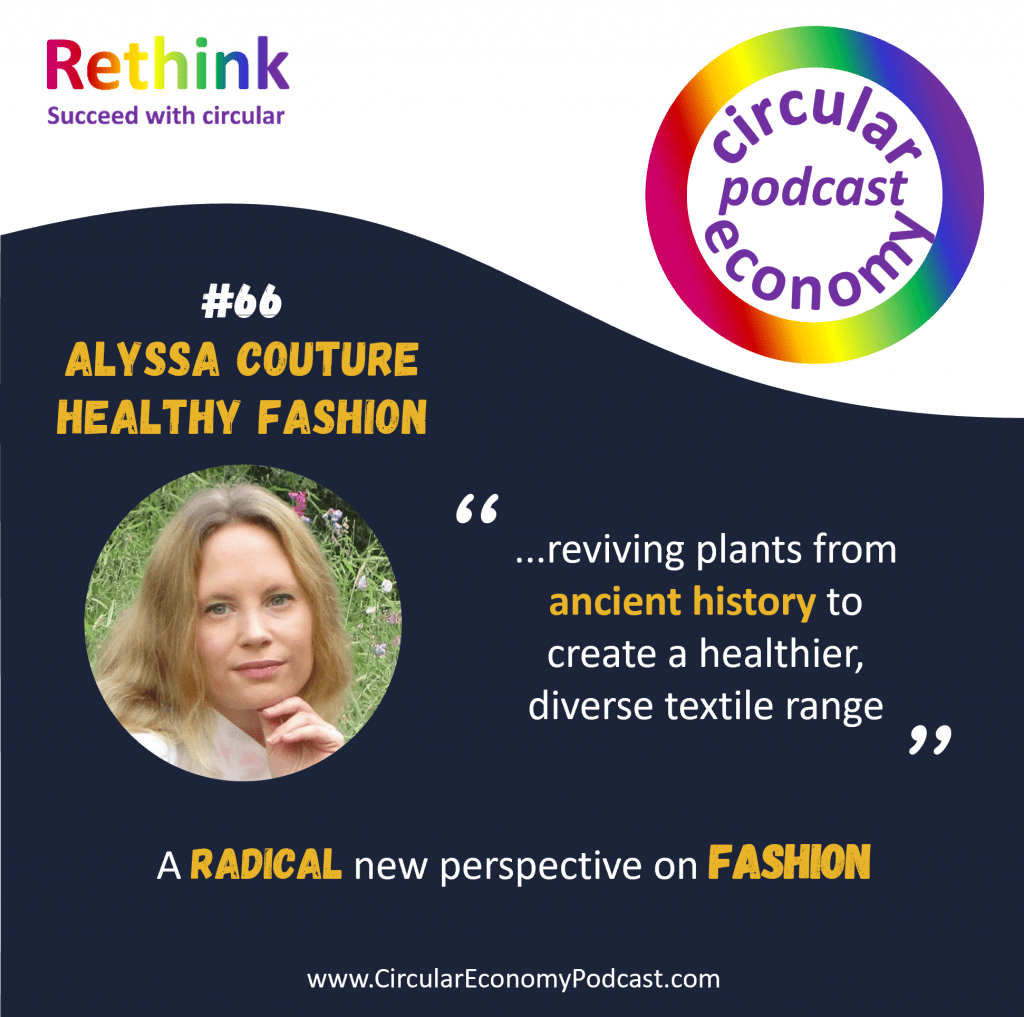
Catherine Weetman talks to Alyssa Couture, the author of Healthy Fashion: The Deeper Truths (published this month). Alyssa’s book is all about fashion for mental health, physical health, spiritual health, and energetic health.
Alyssa brings a radical new perspective to fashion, looking at everything from the textiles and dyes we use, to how our clothes can improve our mental and physical health. Alyssa’s work shows how all of this is connected to our environment and improving sustainability.
We’ll start by asking Alyssa to share some of her research on textiles and dyes, and then discuss a few of the insights from her book, including what ‘unhealthy fashion’ is, and how fashion can evolve to be circular and healthier for us, and our living planet.
Podcast host Catherine Weetman is a circular economy business advisor, workshop facilitator, speaker and writer. Her award-winning book: A Circular Economy Handbook: How to Build a More Resilient, Competitive and Sustainable Business includes lots of practical examples and tips on getting started. Catherine founded Rethink Global in 2013, to help businesses use circular, sustainable approaches to build a better business (and a better world).
Stay in touch for free insights and updates…
Don’t forget, you can subscribe to the podcast series on iTunes, Google Podcasts, PlayerFM, Spotify, TuneIn, or search for “circular economy” in your favourite podcast app. Stay in touch to get free insights and updates, direct to your inbox…
You can also use our interactive, searchable podcast index to find episodes by sector, by region or by circular strategy. Plus, there is now a regular Circular Economy Podcast newsletter, so you get the latest episode show notes and links delivered to your inbox on Sunday morning, each fortnight. The newsletter includes a link to the episode page on our website, with an audio player. You can subscribe by clicking this link to update your preferences.
Links we mention in the episode:
- A Circular Economy Handbook: How to Build a More Resilient, Competitive and Sustainable Business – buy from any good bookseller, or direct from the publisher Kogan Page, which ships worldwide (free shipping to UK and US) and you can use discount code CIRCL20 to get 20% off: https://www.koganpage.com/CircEcon2 It’s available in paperback, ebook and on Kindle. If you buy it from online sources, make sure you choose the new edition with an orange cover!
- Search for episodes by sector, circular economy strategy, person or organisation, using the interactive episode index on our website
- Sign up to get the podcast player and shownotes for each new episode emailed to your inbox
- Website: https://www.hfcampaign.com/
- Instagram: https://www.instagram.com/hfcampaign/
- Facebook: https://www.facebook.com/healthyfashioncampaign/
- Linkedin: https://www.linkedin.com/in/alyssa-couture/
- Pre-order copy of Alyssa’s book, Healthy Fashion: the Deeper Truths https://www.amazon.com/Healthy-Fashion-Deeper-Alyssa-Couture/dp/1789045932
- Lyocell info https://www.theguardian.com/fashion/2019/nov/18/pulp-fabric-everything-you-need-to-know-about-lyocell
- Viscose issues – report by Changing Markets – Dirty Fashion – published in Dec 2020 https://changingmarkets.org/portfolio/dirty-fashion/ and https://dirtyfashion.info/
- Spinnova’s chemical-free viscose process https://www.sitra.fi/en/cases/spinnova-makes-textile-fibres-from-pulp-we-are-the-only-company-in-the-world-to-manufacture-textile-fibre-without-harmful-chemicals/
About Alyssa Couture
Alyssa Couture is an author, fashion designer, and fashion entrepreneur. She is currently focused on her fresh-inspired Healthy Fashion Campaign in conjunction with promoting her upcoming fashion book. Her upcoming book establishes an alternative approach to clothing.
Alyssa is a fashion industry expert, with over 15 years of fashion industry experience in a number of roles. Some of these include fashion business, fashion designing, creative directing, styling, merchandising, journalism, fashion retailing, and fashion show production.
Apart from fashion, she has a spiritually driven lifestyle, having previously lived in several ashrams and monasteries. She is a professional fine artist/illustrator with published and sold works to follow. She is a major foodie and former chef claiming 5 Star reviews. Alyssa has lived and worked in NH, NYC, New Jersey, West Virginia, Michigan, and in her most favored and current location: California. Her love of travel has given her the opportunity to explore different cultures and influence her outlook.
Alyssa is a fashion intuitive. Her sole motive is to bring fashion into its course as a therapeutic, healing tool. To help initiate the consciousness of the human spirit via fashion into its transmission of divine activity for overall human health and wellbeing, as well as it being contributing factor for ultimate planetary awakening.
She is currently promoting her upcoming soon-to-be-released fashion book. The book establishes an alternative, modern approach to clothing; Fashion deemed medicinal. Check her site for more info. Visit: www.hfcampaign.com or email: alyssacouture11@hotmail.com
Interview Transcript
Provided by AI – add ~3:15 mins for the finished episode
Catherine Weetman 00:01
Alyssa Couture is the author of healthy fashion the deeper truths released on December the first this year. Healthy fashion is all about fashion for mental health, physical, physical health, spiritual health and energetic health. Alyssa brings a radical new perspective to fashion. Looking at everything from the textiles and dyes we use to how our clothes can improve our mental and physical health. Alyssa ‘s work shows how all of this is connected to our environment, and improving sustainability. We’re going to start by asking Alyssa to share some of her research on textiles and dyes. And then discuss a few of the insights from her book, including what unhealthy fashion is, and how fashion can evolve to be circular and healthier for us and our living planet. So Alyssa , welcome to the circular economy podcast.
Alyssa Couture 00:53
Thank you so much, Catherine, for having me.
Catherine Weetman 00:55
Yeah, it’s great to see that today on the other side of the Atlantic. And first of all, I’m really curious to hear what brought you to writing a book about healthy fashion. Where did that come from?
Alyssa Couture 01:09
Yeah, so it is a really interesting question. And I took a long time to get it down on paper, it took a couple years. And it was sort of part of my lifestyle and my experience in life. I have visited many ashrams and monasteries, so it brought us spiritual realm in aspect to it. And then I’ve also sort of produced a handmade fashion brand, which was just a small, small batch handmade, fashion brand, but it was important, it got into Saks Fifth Avenue emerging designer Talent Search competition. So it all was produced with hemp and linen and cotton and plant based material. So it was a plant based brand. So that was another part that launched me into writing this book. So there’s many different aspects, I produced a fashion show in 2014. I’ve been in fashion retail for a very long time. So it was a little bit of a hodgepodge of all my different background and fashion and experience. And I also went to design school and Academy of Art University in San Francisco. And that really led me down the path of questioning and trying to theorise fashion in a new light, new way. And there is a lot of people in the industry that is producing healthy fashion. But it’s still not mainstream, it’s still in its minor stages, minor processes. So really, what kind of brought me into writing this book was also I am a writer, I write short stories and poetry. And I used to do that quite often. So I love to write, and it I have a creative aspect to me, I was a fine artist, I don’t believe I’m an artist anymore, because I stopped drawing. I only sketch very rarely. But I started painting and drawing when I was at art school, and back in high school many, many years ago. So this fine art aspect, this creative energy is brought into the book as well. But there’s a very scientific aspect to the book. And there was a lot of research involved. So I bring in sort of the technical, scientific aspect and the spiritual, more creative realms, and it’s a balanced immersion both.
Catherine Weetman 03:42
Hmm, sounds fascinating. And one of the things that really intrigued me about the book was the focus on what we might call new materials. But really, they’re materials from history that we’ve kind of forgotten about. Maybe you could tell us about some of those, the ones that you discovered and thought were really interesting and wondered why we’re not not using these all the time.
Alyssa Couture 04:10
Yes. So when it comes to circular fashion and sustainability, the most realistic way to beat the pollution and the corruption in the fashion industry is to start a circular fashion economy. And part of that is going plant based. And you really cannot be entirely plant based. If we just focus on cotton and linen, we have to develop and produce multiple different textiles and multiple different types of plants. And so from my research I’ve gathered in South America in history, they used 500 to 700 different types of plants for textile use, and with that type of number. I actually I only gathered 35. But very important plants from history that in that have been produced in minor moderate in major phases of production, mass production and minor production. And some plants are supposed to be produced in minor phases and never be produced in mass phases. And some are supposed to be produced in mass phases, like cotton and linen. So we have different types of fabrics. And I produce this glossary to showcase really what we can do for the fashion industry, what we can do globally at large. And some of the fabrics being nettle, hemp, bamboo, abaca, cactus, Pina, banana, there’s so many, and the only 35 that I’ve showcased are very important, but there’s so many others that I didn’t even talk about. So I’m just giving a little bit of a taste of what we can do. And it would be actually important to start focusing on these 35 types of plants based on the research that I have provided in the book, because they have such therapeutic properties, because they are produced and developed and founded globally in different countries of the world. So we’re really gathering you know, these types of plants that are significant and say countries in America. Sasa washi, and Europe there’s the nettle plant in China, there’s bamboo. In Mexico, there’s Agave. So there’s all these different types of plants and all these different types of countries. And when we all gather together, and we produce these different plants, we’re going to reduce the polyester, which is sort of exploited the industry at two extreme ways. I believe 90% of the industry is manmade Rayon, polyester, acrylic, acetate. And it’s sort of a non renewable resource, which is kind of not circular at all. Even even if we do try to prevent waste and landfill use with polyester that doesn’t biodegrade, we’re still developing a vicious cycle to produce more and more plastic. So really, with when we go plant based, we’re also going to downsize because our products are going to be more precious to us because plants are a sacred medicinal medicine to us, we eat plants, and we should wear plants, plants should be a part of our external environment, in a health pursuit in a medicinal pursuit, and also in an environmental pursuit, most importantly,
Catherine Weetman 08:00
yeah, and I’d like to come come back to that. So thinking about one of the criticisms of of cotton particularly is all the irrigation and pesticide use. And of course, Cotton’s now being produced in very water scarce areas. So it’s, it’s not even a suitable plant for that particular region of the world. And you’ve listed a number of plants from different regions. So I’m assuming that you know, those grow well there. And some of those sounded like they were byproducts of food production anyway, similar to the pineapple leaves for pain attacks. So already we’re starting to support farmers with more profitable ways of growing things because now you’ve got two or several products. And there’s a slide I like to use in in talks with all the different uses of hemp. You know, there’s about 5050 different things you can use hemp for. So suddenly a farmer has got a whole range of different markets he can sell into. So I think that’s that’s really interesting that as well as it being healthier to where there’s the health of the planet, because we’re growing things where they’re, you know, what were they were always grown, where they’re suited to growing. And we’re growing things that don’t require masses of irrigation, pesticides, fertilisers, so it’s lighter on the planet, and it’s lighter on the farmers input costs. Does that does that make sense in terms of your findings?
Alyssa Couture 09:36
Oh, that’s exactly that’s exactly where I’m going and where I’m coming from. And, you know, we’re dealing with planetary awakening here. And this is not just from climate change, or the environmental corruption and pollution in the world. We’re dealing with going into a more holistic, healthier standpoint, you know, no longer we going to be using the plastic knives in Tupperware, we’re going to be using vegetable based Tupperware and vegetable based knives and forks and everything. So different industries are all kind of going onto this plant based process and plan so that we can sort of combat the use of petroleum, which is sort of the worst and non circular thing that we can do for the fashion industry and other industries. And I wanted to break it down a little bit because you had mentioned call in and call in is sort of non-GMO. The non-GMO cotton is really pleasant cotton, about 80 and 90% of cotton right now it’s gentlemen genetically modified, which is a problem because it’s it’s hurting the land, it’s creating issues with, how it’s being grown and how it’s being processed. But where I’m coming from is there’s different categories that we can sort of bring about in making this plant based fashion industry possible. And right now there’s I don’t even believe there’s I think there’s about 5% of plant based fashion being produced at this point, just really not good. But we have different categories like wild weeds, we have ways of permaculture farming. We have natural waste resources. I know that in Europe, they’re using pine needles to be producing a Viscose, but it would be better to use a lyocell process. But pine needles is a natural resource. And it’s a waste of resource and that we can use. There’s also the desert lands that aren’t really being occupied. Mostly they we could be farming cactuses. And we could be using the gel for food and we can use the skin. For textiles. Some of the textiles we can use would be palm, pandan leaf, agave and Aloe Vera. So we have the desert, the wetland, wild weeds, the permaculture, the natural waste plant resources from the food industry and just from the wild forests, we also have seaweed farms, we could develop more and more seaweed farms and not take away from the planet but flourish the planet we can we don’t have to take the resources we flourish and we we act like Native Americans, we only take three quarters or a quarter of what is being harvested, we can do it in a very sustainable way we can do it in a holistic way. And way that doesn’t take but is a receiving in a taking its natural way of life, which is very circular, which is very healthy and is going to I believe just bring the consciousness level on this planet to heights greater heights.
Catherine Weetman 13:17
Yeah, and I think there are some really, really good ways of thinking about those plants. If you think about the, you know, a, is it more attractive for a farmer to go for a multi use plant that can have where you can have markets in in food and medicines and cosmetics as well as apparel? Is there a way of harvesting wild weeds though? I guess we’ve got to be careful there not to make those make those too attractive because then you know what we’re what we’re finding in the UK with foraged food, is that people then start to want to use that as a business and overharvest and then we’re back to things not being sustainable, because, you know, people want to exploit nature for profit. And we’re back to the same, the same problem that we’re that we’re trying to resolve. So I think there are, it sounds like there are, you know, loads of really interesting examples in the book for people to read more about. And one of the things I was interested to explore with you was some of the other issues, even with natural fibres, the way that we produce things currently. And this was a kind of eureka moment for me when I was reading some info from Patagonia a few years ago was that they had some problems with people getting sick in a store that they just stocked with new products, and they didn’t realise it was anything to do with the products did all sorts of tests on you know the decoration and the fittings in the store, and To try and work out what it was, and it turned out to be all the stocks of new cotton clothing that they’ve put in this is probably 2030 years ago this happened. And they did some analysis and realise that although it was organic cotton, it had probably about 30% of the fabric itself was finishing chemicals and dyes, including formaldehyde. So that just completely shocked them to the core when they realised that although they were buying an organic fibre, the processing of that into a textile was anything but organic. And so I know you’ve done some work around plant based and mineral based dyes and finishing chemicals that that could be used instead of the synthetic ones, maybe you could talk us through a few of those.
Alyssa Couture 15:49
Yes, so we have different types. And that was all very interesting, what you said and everything to considering that I believe that there’s needs to be some kind of government involved and there has to be, you know, national parks are protected, we have to, you know, create sacred land. We need to make way and room for bringing more ecology healthy ecology to the planet. And that is where bringing in the the new plants and harvesting from, say wild bees, we have to get government officials involved, we have to bring in the environmental activists and environmental workers into the picture so that we do it in an appropriate way because it could be a disaster a science experiment, but it also could be a blossoming paradise. But for the textiles as you said, this is also a large part of the circular fashion. We can use textile dyes from roots, we can use them from flower petals, lichens and mushrooms. However, that would have to be in a minor phase production because because the forests depend on them. We could use seaweed and algae for textile dyes, we could crush crystals into pigments, we could use our soils and clays. And we can also use food like berries and tea leaves and all sorts of fruits and vegetables. And I know that there’s one company that’s turning the food waste into a freeze dried powder, and that in turn, they use as a textile dye. So there’s a lot of new developments. I know that textile dye is very expressed in the minor kind of bohemian local types of ways of producing it. It’s very highly advertised as being sort of elite and being only showcased for small batch production. But there is definitely a way for us to be able to produce them at a larger scale. I know Archroma is a textile dye supplier, and they do produce in chemicals. But they also have a specific type of textile sampling that they do. And it’s a large mass production of using you know a corns and different types of natural waste resources that we have handy and they produce them and make a wide variety of beautiful grounds and reds and blues and greens. So yes, it is possible. It’s just not common. It’s not a mainstream, it’s not standard, and that’s sort of where we want to go with circular fashion and the circular economy.
Catherine Weetman 19:10
Yeah, and I think Archroma that he mentioned I think I’m writing saying that they’re a supplier to Patagonia that we were just talking about, and Patagonia has developed a clean colour collection though when I was looking last looking online I could only find it listed in the Patagonia Australia website not on the main one for some reason, but some of the examples they gave included a rich green die that came from Chinese silkworm excrement and we could well i’m sure we wouldn’t debate the the ethics of farming silkworms but I guess you know, maybe maybe there’s another another way of harvesting excrement from insects and then citrus brown less controversially is made from bitter orange peel that itself being a residue from herbal remedies. So again, it’s the kind of multipurpose use, isn’t that. So I think the fact that Patagonia forging ahead with those kinds of developments is is encouraging. And one of their principles is that they like to share what they’re doing with with other companies to try and encourage others to do it. So I think you’re right, that we could be seeing lots of lots of new developments in that area. And it gives people in universities and you know, people with innovative and creative and scientific expertise, a whole new research area to get into and come up with some exciting new dyes, dyes and chemicals. So we’ve talked a bit about the fibres. And I know, in the, in the book, you encouraged us to think about, think beyond just the bill of materials and choosing different fibres. But the fact that we could use more advanced machinery to make it easier to produce these textiles from those new fibres. Could you unpack that a bit for us?
Alyssa Couture 21:16
Yes, and I am, you know, I’m not in textile manufacturing. But I do know quite a bit that there is there has been advances and say, developing kina. In the Philippines, there’s been some textile development phases of developing Pina pineapple leaves and textiles. So it’s a machine specifically for Pina leaves, and another scientist developed a machine that could take the corn husk off of the corn and develop a fibre from the corn husk. And this machinery is, you know, there’s no labour involved, you’re not you know, you’re not going into a field and picking it by hand, we really have to take advantage of building machines that could not put too much labour on the labour workers because we want to advance society, we don’t want to go back in time and spend hours and hours on a loom, which is not a bad thing, because there are artists all over the world that are keeping a tradition and holding it sacred. But we do, we do have to think about the underdeveloped countries of the world, and sharing advanced technology and machinery so that they can advance as a community in a society. And I think textile production could be an important part for global advancement, it could really open a new gamut of trying to help support the workers and the labourers, and not put too much stress and not too much put physical stress onto the human. It’s really about advancing the textile industry. And it’s not just going back in time in ancient history, and working on these types of machines that are really not going to produce the way we want to produce. And it’s not either turning into like a polyester lab where there’s just so much polyester that can be reproduced. And so little time, we want to still make it slow, make it circular, make it also advanced, there’s a balance involved. But I think that with new textile machinery, it’s really going to affect the world. And it’s being done it’s it’s being done in multiple countries. They’re choosing to produce in different types of plants. And they’re choosing to create textile machinery dedicated to these two different types of plants like pine needles, we have to develop something to create this goes into a textile and we don’t have to do everything sell cellulose and everything worked by threat we can make the lyocell process we can choose to use plants and make it into a lifestyle process like 10. So Tencel’s A perfect example of a machine they use to bring bring the plant solution into a spinnerette and then it would weave much more quicker than other types of processes.
Catherine Weetman 24:39
So I guess what we’re trying to do is replace some of the very labour intensive processes I remember when I first learned about pain attacks and the using the fibres from the pineapple leaves which are incredibly long, which makes them really useful as a to make a fibre from but it’s very labour. intensive process and hence traditionally would be used for things like wedding dresses because that was something that the community would all put a lot of time into, you know, creating a fibre to make somebody a wedding dress. But if we want these natural fibres to compete on, on cost, you know even if they’re a bit more expensive but we want them to compete on cost really with synthetics and with cotton, otherwise it’s only going to be suitable for the luxury and you know, we want to democratise these materials so finding a balance between creating meaningful and enjoyable employment not monotonous employment or not, you know sitting sitting peeling fibres from pineapple leaves day after day after day then we have to get this balance right Don’t we have the technology and the machinery but still but not automating it beyond the point where we’ve hardly employed anybody and these these jobs have got to be you know, living wage jobs and you know, not not dangerous we don’t want to go back to the time of the Industrial Revolution in the UK when you know, children and women will be doing incredibly dangerous, dangerous jobs for long hours. So can I I’m going to ask you put you on the spot a bit now with one of the fabrics that I’ve got a really bad gut feel about and just see see what your thoughts are on that. So in the UK particularly, there are an awful lot of adverts for eco bamboo and I know that bamboo grows you know like a weed without any pesticides irrigation it’ll grow really well. But I can never get under the skin of the process and when I when I’ve have investigated it seems as if only a tiny proportion of bamboo is made on a closed loop process where all the process process chemicals to turn the bamboo stalk into a fibre are kept within the factory and not allowed out into the environment. And that most of it is just as bad as a lot of the other synthetic processes. So maybe you could give us your your take on that.
Alyssa Couture 27:21
Yes, I agree with you 100% the viscose bamboo is not being produced and healthy way and i i have read and you’ve been very discouraged about bamboo because bamboo is a plant that is extremely sacred and to be put on the body energetically would be very healthy and therapeutic. So I did walk into a boutique about a year ago and I saw this beautiful scarf and it was made in a bamboo linen. So it was made like linen, it was a naturally a natural process of producing bamboo and it was soft, and it was beautiful. And it was nice. So I think the bamboo lyocell which is rare, but should be produced much more significantly is an important part of bringing bamboo bamboo into the fabric scene. And as well as bamboo linen, you know, not heavily processed, still soft and supple and a great fabric for apparel. But yes, this whole exploitation of bamboo viscose has really taken over and you know, it’s on some advertisements I’ve even seen on a pillow. They call it bamboo. But it’s a it’s literally polyester. They’ve used the name bamboo and they’ve completely exploited the fabric and textile entirely.
Catherine Weetman 29:03
Wow. Wow. So yeah, so another example of of greenwashing. Which I’m sure, like, like many others working in circular economy and sustainability you get fed up with as well, of all the sort of, you know, random acts of greenness that people get really good PR out of and yet you look at it and think well, if you solve one little problem but created a whole lot more because it’s you know, it’s not actually any better. So that’s, that’s, that’s really interesting. So the book’s coming out in December, Alyssa, have you got launch events planned or are you going to do it virtually how’s how’s that gonna work?
Alyssa Couture 29:46
Well, I’m still working on the launch projects. And this is my book tours part of my launch. So I thank you so much for having me and I’ve enjoyed every minute of it. But my book is going to be released December 1st 2021 – it’s something that I’ve been looking forward to in a milestone in my life and career. So I’m, I’m very privileged to be able to publish a book as yourself, you are also an author. It’s an exciting opportunity. I’ve had this idea for many years, and being able to put it into a book and being able to share it. And being an advocate and activist for circular fashion is definitely a responsibility. So I just can’t wait to see the outcome and see what happens. Yeah,
Catherine Weetman 30:38
yeah. So it’s all very exciting. So don’t forget to get somebody to do a video of you opening the first box of books that arrive at your house, that’s supposed to be one of the the typical things that authors do is, you know, the book opening or the box opening ceremony. But yes, it’s. So where would people be able to find out more about you and the book Alyssa?
Alyssa Couture 31:03
Yes, um, you can find me at my website, www dot h, f. h, s, and healthy Fs and fashion campaign.com. I have a specific tab on the top that says fashion book. And that’s where you can read some more information about the book, I have a Q&A on there. You can also reach me on my social media I have on my website, several social media, social media accounts, Instagram, Facebook, Twitter. And if you want to go straight to finding the book, you can go to Amazon, Barnes and Nobles indiebound, you just have to type in Healthy Fashion, the deeper truths. And that’s where you’ll find the book. And like I said, there it is heavily involved with circular fashion, sustainable fashion, eco fashion fashion for the environment, it does talk a lot about fashion for health and topical therapeutic treatment, but is very heavily involved in advocating an active activating fashion, consciousness, environmental fashion consciousness. So it is also represented in 35 different bookstores that I’ve googled, I know that there’s more out there that are representing the book and selling the book. But if you just Google search it you’ll definitely find it and like I said, it’s it’s a very happy time for me. And I can’t wait for the outcome and see what happens.
Catherine Weetman 32:36
Yeah, should be really exciting. And there’s lots of work going on isn’t there to bring bring the skills of making and mending back to life. And of course, to encourage people to experiment with these traditional natural fibres that are healthier for us healthier for the farmers and healthier Of course for the planet. And that’s what we we need more than ever. So Alyssa, thank you very much. And I’ll put those links in the show notes at circular economy. podcast.com. And yeah, good luck with the lunch. Thank you.
Alyssa Couture 33:53
Thank you so much for having me, Catherine.
Want to dig deeper?
Why not buy Catherine’s award-winning book, A Circular Economy Handbook: How to Build a More Resilient, Competitive and Sustainable Business. This comprehensive guide uses a bottom-up, practical approach, and includes hundreds of real examples from around the world, to help you really ‘get’ the circular economy. Even better, you’ll be inspired with ideas to make your own business more competitive, resilient and sustainable.
Please let us know what you think of the podcast – and we’d love it if you could leave us a review on iTunes, or wherever you find your podcasts. Or send us an email…
Podcast music
Thanks to Belinda O’Hooley and Heidi Tidow, otherwise known as the brilliant, inventive and generous folk duo, O’Hooley & Tidow for allowing me to use the instrumentals from the live version of Summat’s Brewin’ as music for the podcast. You can find the whole track (inspired by the Copper Family song “Oh Good Ale”) on their album, also called Summat’s Brewin’. Or, follow them on Twitter.
